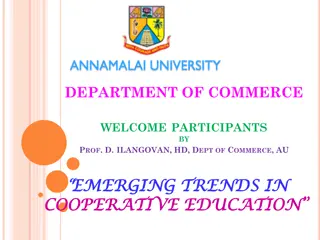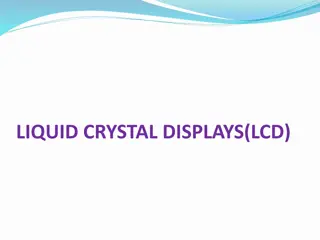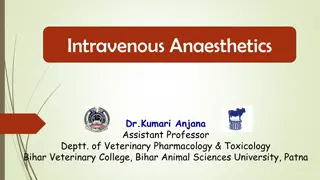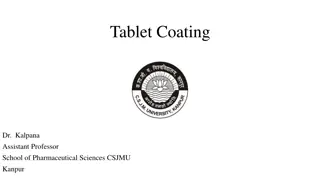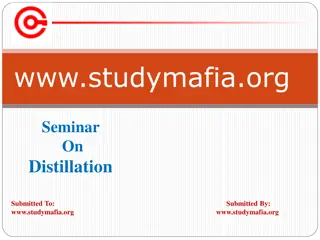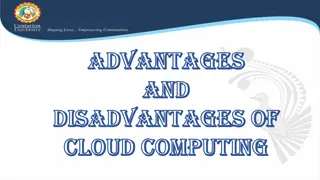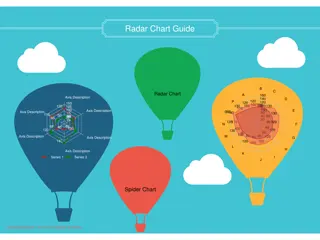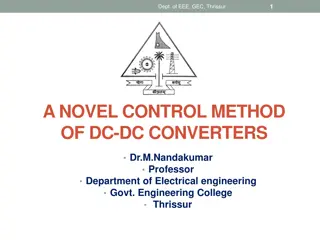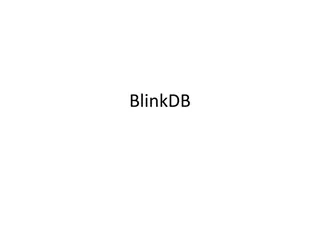Overview of Education System in India: Structure, Advantages, and Drawbacks
Education system in India comprises various types of schools and institutions, each catering to different affiliations. The instructional structures and stratification focus on quality, equity, and management, with key institutions like NCTE and NCERT shaping education policies. Despite advantages like basic knowledge acquisition, the system faces drawbacks such as rote learning and theoretical syllabi. Overall, the quality of education in India is influenced by financial and political factors.
Download Presentation

Please find below an Image/Link to download the presentation.
The content on the website is provided AS IS for your information and personal use only. It may not be sold, licensed, or shared on other websites without obtaining consent from the author.If you encounter any issues during the download, it is possible that the publisher has removed the file from their server.
You are allowed to download the files provided on this website for personal or commercial use, subject to the condition that they are used lawfully. All files are the property of their respective owners.
The content on the website is provided AS IS for your information and personal use only. It may not be sold, licensed, or shared on other websites without obtaining consent from the author.
E N D
Presentation Transcript
The System and Its Structure Presented by: Dr. Gopal Singh
The System and Its Structure Schools in India -Types and Affiliation - Schools run by autonomous of the institutions of the Central Govt. (KVS, NVS, Sainik Schools, etc.) - Schools run by the State Govt. - Private Schools - International Schools
Looking at instructional structures and stratification within the context of concerns : - Quality - Equity - Management - Public participation
Role of key institutions in shaping the policy and discourse of education: - NCTE - NCERT - NIOS - Board of Education
Role of Directorates of Education and local bodies: - Panchayati Raj institutions - Municipal bodies
Introduction Education is the process of learning or getting of knowledge, skills, values and habits of essential needs of life. Education system is differ from one and another country, not all the countries are following education system. a common
Advantages of Indian Education System By comparing with other countries only in India every student have a basic knowledge about all the subjects. Only schools in India follow the regular attendance method, so that students will gain basic knowledge about their daily habitation and life needs. Students go through many exams in their learning years, It teachers them to analyze their own strength consistently. and weakness
Drawbacks & Suggestions In India up to 85% (approx.) of students where used to memorize the content in the books and used to write the same words in the exams. Only 15% (approx.) students where used to understand the concept of the subject and can able to answer in their own words. The syllabus is mostly in the form of theoretical basis, there subjects contains practical contents. is only few
In India, The quality of education is depending upon the money and politics, these two things rules the education now a days and makes the education as a corporate business in India. There are still many single teacher schools in many villages. Indian govt. needs to invest large amount in order to develop the infrastructure of schools and colleges.
Methods changes, teachers should encourage the students to think logically & to increase creativity in students. In India, the physical education has no primary importance with comparing to other subjects, there is no proper syllabus and no regular periods are allocated for physical education. of teaching needs more
The System and Its Structure Schools in India -Types and Affiliation - Schools run by autonomous of the institutions of the Central Govt. (KVS, NVS, Sainik Schools, etc.) - Schools run by the State Govt. - Private Schools - International Schools
What is School? A school is an educational institution designed to provide learning spaces and learning environments for the teaching of students (or "pupils") under the direction of teachers. Most countries have systems of formal education, which is commonly compulsory.
Stages or Levels of School Education in India Primary Schools (1-5) Upper Primary Schools (6-8) Secondary Schools (9-10) Higher/Senior Secondary Schools (11-12)
Primary School Education - Primary School Education is provided from 1st Class to 5th Class.The children admitted in these school are generally aged between 6-11 years. Middle School Education - Education which is provide from 6th class to 8th Class is called Middle School Education.Children reaching this level are generally aged between 11-14 years. Secondary School Education - Secondary stage of school education starts from 9th class onwards to 12th class. Students studying at this level are generally aged between 14-17 years.
Types & Affiliation Schools run by Autonomous Bodies Schools run by State Govt./Board Private Schools International Schools
Schools run by Autonomous Bodies Central Board of Secondary Education (CBSE) Central Tibetan Schools Administration (CTSA) KendriyaVidyalaya Sangathan (KVS) National Council of Educational Research & Training (NCERT) National Council for Teacher Education (NCTE) National Institute of Open Schooling (NIOS) NavodayaVidyalaya Samiti (NVS) National Bal Bhavan
Central Board of Secondary Education (CBSE) The first education board to be set up in India was the Uttar Pradesh Board of High School and Intermediate Education in 1921, which was under jurisdiction of Rajputana, Central India and Gwalior. In government of India set up a joint Board named "Board of High School Education, Rajputana". This included Ajmer, Merwara,Central India and Gwalior.Later it was confined to Ajmer, Bhopal and Vindhya Pradesh. In 1952, it became the "Central Board of Secondary Education". 1929, the and Intermediate
Formation Type Headquarters Official language 3 November 1962 (57 years ago) Governmental Board of Education New Delhi,India Hindi English Manoj Ahuja, IAS Ministry of Human Resource Development 21,499 schools (2019) cbse.nic.in Chairperson Parent organisation [1] Affiliations Website
Main Objectives To define appropriate approaches of academic activities To analyze and monitor the quality of academic activities To develop norms for implementation of various academic activities To organize various capacity building and empowerment programs to update the professional teachers competency of
To examinations examination at the end of Class X and XII. To grant qualifying certificates to successful candidates of the affiliated schools. To affiliate institutions for the purpose of examination and raise the academic standards of the country. To prescribe and update the course of instructions of examinations prescribe conditions conduct of and public
Affiliations CBSE affiliates all Kendriya Vidyalayas, all Jawahar Navodaya Vidyalayas, private schools and most approved by central government of India. of the schools
Functions Affiliation Curriculum Examination Finance
Kendriya Vidyalaya Sangathan (KVS) The system came into being in 1963 under the name 'Central Schools'. Later, the name was changed to Kendriya Vidyalaya. Its schools are all affiliated to the Central Board of Secondary Education (CBSE). A uniform curriculum is followed by the schools all over India. By providing a common syllabus and system of education, the Kendriya Vidyalayas are intended to ensure that the children of government employees do not face education disadvantages when their parents are transferred from one location to another. The schools have been operational for more than 50 years.
Established 15 December 1963 School board Central Board of Secondary Education (CBSE) Authority Ministry of Human Resource Development Commissioner Mr. S. K Mall, IAS Affiliations 1235 schools & 03 abroad (2019) Website www.kvsangathan.nic.in
Main Objectives To cater to the educational needs of the children of transferable Central including Defense and Para-Military personnel by providing a common programme of education. To pursue excellence and set pace in the field of school education To initiate and promote experimentation and innovativeness in education in collaboration with other bodies like the CBSE and NCERT. To carry out Educational Research and Training etc. To develop the spirit of national integration. To Provide, establish, endow, maintain, control & manage schools. Government employees
Salient Features Common text-books and bilingual medium of instructions for all Kendriya Vidyalayas. All Kendriya Vidyalaya are affiliated to CBSE. All Kendriya Vidyalaya are co-educational, composite schools. Sanskrit is taught from class VI - VIII. The quality of teaching is kept reasonably high by an appropriate teacher-pupil ratio. No tuition fee for boys upto Class VIII, girls upto Class XII and SC/ST students and children of KVS employees.
Navodaya Vidyalaya Samiti (NVS) Jawahar Navodaya Vidyalayas (JNVs) is a system of schools for talented students predominantly from rural area in India. They are run by Navodaya Vidyalaya Samiti, New Delhi, an autonomous organization under the Department of Literacy, MHRD, Government of India. JNVs are fully residential and co-educational schools affiliated to Central Board Education (CBSE), New fromVI to XII standard. JNVs are specifically tasked with finding talented children in rural areas of India and providing them with an education equivalent to the best residential school system, without regard to their families' socio-economic condition. School Education and of Secondary with Delhi, classes
Jawahar Navodaya Vidyalaya Location : All over India except state of Tamil Nadu Other name JNV, Navodaya Established 1986; 34 years ago Founder Government of India School board CBSE Chairman Shri Ramesh Pokhriyal Grades VI - XII Age range 11-19 yrs Schools & Students 661, 273759 as of 30 September 2019 Campus size 30 Acres each school Color(s) Navy blue Website navodaya.gov.in
Region-Wise Break-up of JNVs Bhopal - 113 Chandigarh - 59 Hyderabad - 77 Jaipur - 65 Lucknow - 89 Patna - 85 Pune - 73 Shillong - 100
Sainik Schools The Sainik Schools are a system of schools in India established and managed by the Sainik Schools Society under Ministry of Defence. They were conceived in 1961 by V. K. Krishna Menon, the then Defence Minister of India, to rectify the regional and class imbalance amongst the Officer cadre of the Indian Military, and to prepare students for entry into the National Defence Academy (NDA),Khadakwasla,Pune and Indian Naval Academy. Today there are 33 such schools running and proposed for future covering all the states of the country
Uttar Pradesh - Sainik School, Lucknow Sainik School Lucknow was established in July 1960. The only one of the Sainik Schools to be administered by the state government, the alumni of which, Captain Manoj received Param Veer Chakra. It was the first Sainik School in the country, and was followed by the setting up of other Sainik Schools, under the Ministry of Defence, Government of India, on the same lines. The education in this school is subsidised by the Government of Uttar Pradesh. It is a boys' residential English medium school affiliated to CBSE Board. Pandey, posthumously
Objective of Sainik Schools The objective of the Sainik Schools is to prepare the students to lead as officers in the Defence Services of the country. The schools select bright and promising students through a national entrance examination and focus on moulding their overall personality with extracurricular activities. emphasis on
State boards As the name suggests, each state has its own board of education that conducts certificate examination for class 10 and class 12. Some state boards, such as Rajasthan board also conduct exams in class 8. Each state in the country has its own Department of Education that runs its own school system with its own textbooks and evaluation system. As mentioned earlier, the curriculum, pedagogy and evaluation method are largely decided by the SCERT in the state, following the national guidelines prescribed by the NCERT.
Board of High School and Intermediate Education Uttar Pradesh The Board of High School and Intermediate Education Uttar Pradesh is the Uttar Pradesh state government administered autonomous examining authority for the Standard 10 examination (or secondary school level examination) and Standard 12 examination (or inter college level examination) of Uttar Pradesh, headquartered in Prayagraj, India. Presently this board enjoys the tag of Asia's largest board in terms of no. of students. The examination for the 10th and 12th standard is called the High school examination and Intermediate examination respectively. The High school and Intermediate examinations are conducted annually and simultaneously all over the state of Uttar Pradesh. The Board holds the examinations and prepares the results of nearly 32,00,000 students.
Board of High School and Intermediate Education Uttar Pradesh Established 1921 Type Government Organisation Headquarters Sector 32, Tashkand Marg,Prayagraj, Uttar Pradesh-211001 Uttar Pradesh Region Official language Hindi Parent organisation Department of Education, Uttar Pradesh,Government of Uttar Pradesh Website http://upmsp.edu.in
Private Schools They are some of the most popular ones that most parents get their kids into these days. They have much better facilities when compared to government schools. But then their fees is also much more than that of the government schools
International Schools These schools are gaining popularity these days. The international schools is totally different as they follow the syllabus of a foreign country. The languages taught are also foreign. These schools are good if you want your kid doing college in a foreign country. curriculum of
Boarding Schools These schools not only take care of the studies but also accommodation. Kids come and stay away from their family. Many parents prefer them over the other kinds of schools. We have best boarding school in India - Dehradun. see to the some of the
Special Schools Kids with disabilities cannot be put in the same school as other kids because of the level of competition. That is exactly why there are a number of special needs school these days for kids with different kinds of disabilities. They are provided a non formal education.
Looking at instructional structures and stratification within the context of concerns : - Quality - Equity - Management - Public participation
Quality Education A quality education is one that focuses on the whole child the social, emotional, mental, physical, and cognitive development of each student regardless of gender, race, ethnicity, socioeconomic geographic location. It prepares the child for life, not just for testing. status, or
The four pillars of education Learning to know, by combining a sufficiently broad general knowledge with the opportunity to work in depth on a small number of subjects. This also means learning to learn, so as to benefit from the opportunities education provides throughout life. Learning to do, in order to acquire not only an occupational skill but also, more broadly, the competence to deal with many situations and work in teams. It also means learning to do in the context of young peoples' various social and work experiences which may be informal, as a result of the local or national context, or formal, involving courses, alternating study and work. Learning to live together, by developing an understanding of other people and an appreciation of interdependence - carrying out joint projects and learning to manage conflicts -in a spirit of respect for the values of pluralism, mutual understanding and peace. Learning to be, so as better to develop one's personality and be able to act with ever greater autonomy, judgment and personal responsibility. In that connection, education must not disregard any aspect of a person's potential: memory, reasoning, aesthetic sense, physical capacities and communication skills.
A Broad Concept of Quality Education (at a glance) Diversity and flexibility Curriculum Regulation Classroom practices/assessment analysis Pertinence Rights, 4 pillars, meanings Curriculum Regulation Practices/assessment Relevance Objective achievement, curriculum management Access Completion Students academic achievement Teachers (who are they, conditions, practices) Climate Efficacy Quality Education Finance, resources management, social responsibility Management, participation Availability/use of resources Efficiency Inclusion, equal opportunities, resources Achievement parity (efficacy) Tendencies Alternative education/positive discrimination Equity 44 Adopted from UNESCO, 2003.
Equity Educational equity, also referred to as "Equity in education", is a measure of achievement, fairness, and opportunity in education. The study of education equity is often linked with the study of excellence and equity.
Factors of Equity Educational equity depends on two main factors: Fairness Inclusion
Equity vs. Equality Equality means treating everyone the same under the law Equity involves giving people the treatment they need
Diversity Diversity is everything that makes people different from each other. This includes many different factors: Physical Racial Linguistic Religious Caste





